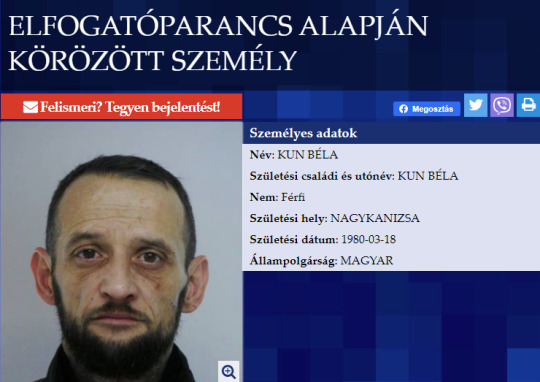#béla kun
Text

Béla Kun circa 1903
2 notes
·
View notes
Text
Ezt a képet
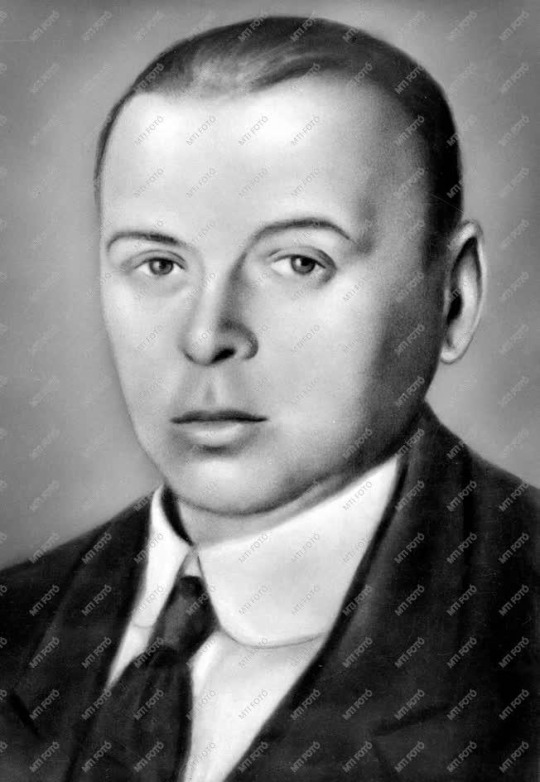
se láttam még: Béláról, aki rég elköltözött.
youtube
0 notes
Photo

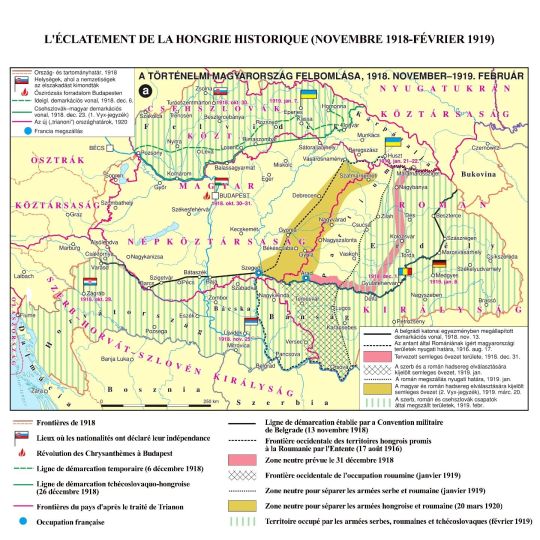
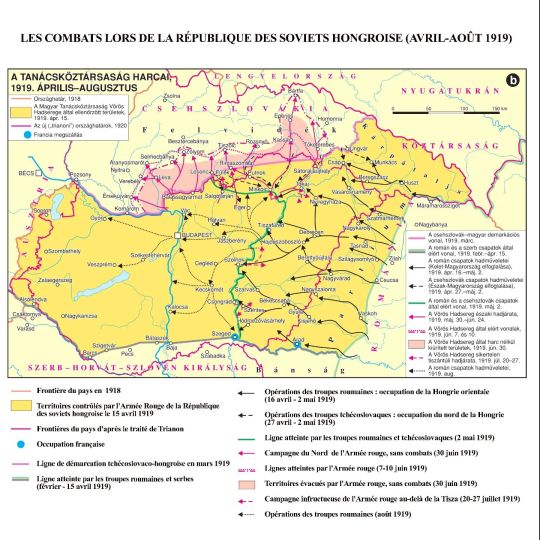
Hungary in 1918-1919
Nicolas de Lamberterie, 2020
"Történelmi atlasz - Középiskolásoknak", József Kaposi, 2016
by cartesdhistoire
Defeats on the front, rising prices, and the agitation of foreign peoples created a troubled situation in Hungary, and in January 1918, a general strike paralyzed activity in Budapest. At the instigation of certain former Hungarian prisoners freed from Russia by the Treaty of Brest-Litovsk and converted to Bolshevism, mutinies took place, and a new general strike of a political nature extended to the entire country on June 20.
On the night of October 29 to 30, Count Mihály Károlyi became the head of government of a de facto independent Hungary: it was the Aster Revolution which established the Hungarian Democratic Republic (November 16).
The head of the inter-allied military mission, the Frenchman Fernand Vix, demanded a retreat of the Hungarian armies by 100 km, an ultimatum which led to the fall of Károlyi and the formation of a government in the hands of the journalist Béla Kun, who had returned from Russia where he had been a companion of Lenin: the Hungarian Soviet Republic was proclaimed on March 21. To face the armed offensives of its neighbors, the government formed a People's Army which, after some successes against the Czechs, was defeated by the Romanians who advanced on Budapest. Béla Kun left the capital on August 1, two days before the arrival of Romanian and Serbian troops supported by French forces (missions led by Berthelot and Franchet d'Espèrey, respectively).
The Bolsheviks' rise to power was poorly received in the provinces and among the Allies. In the southeast of the country occupied by French troops, a national government was formed in June in Szeged whose army was entrusted to Admiral Horthy who, at the time of Béla Kun's fall, already controlled the entire South and West of the country. After negotiating the departure of the Romanians with the Entente, Horthy entered Budapest at the head of his army on November 16. The assembly elected him regent of Hungary on March 1, 1920.
50 notes
·
View notes
Text
Stratégiai nyugalom
Nemzeti értékrend
Nekünk ebből a háborúból ki kell maradni
Magyarérdek!
Családérdek!
Sorosterv!
Fürkészünk és portyázunk!
Hátha leesik valami a kamionról
Rezsigázkőolaj
Hol a faszban a dílerem!
Béke! Béke! Béke!
A magyar nép katonanép
Keresztény értékekkel!
Sohasem fogom kimosni a számból Lavrovot…
Hol a picsában lehet
ebben a szaros városban koxot szerezni?
Just one fix!
Kereszténydemokrácia
A Geccnek persze könnyű
Ő legálban tolja
Rivotrilra páleszt
Putyin békepapagája
Mikor lesz már ennek vége?
Hogy kerültem ebbe a majomketrecbe?
Hazám, hazám, te mindenem!
Baszki bogarak mászkálnak a bőröm alatt!!!!
Csak az a döglődő Putyin meg ne nyomja
Azt a piros gombot
Akkor fölöslegesen építettem magamnak futsalpályát
Baszki Kun Béla, Rákosi és Kádár nyomdokain
Moszkvába járunk faszt szopni
Ezek a genya ukránok miért nem adják meg magukat?!!!
Fogadják vendégszeretően az orosz felszabadítókat
Széttárt combokkal és pucsító seggel
Mint az én őseim
1848, 1945, 1956 magasságában
Just one fix
Where is the exit?
Békeharc!!! Békeharc!
Nem gyenge bástya
Hanem erős rés vagyunk
Az EU várfalán!
Just one fix!
92 notes
·
View notes
Text
On this All Hallows' Eve I recall an old leftist article from an italian site.
The characters are:
Dracula comunista
Commissario del Popolo per gli Affari esteri Béla Kun
aristocratico István Bethlen
sanguinario ammiraglio Miklós Horthy
Friedrich Wilhelm Murnau
Boris Karloff
#tag yourself
5 notes
·
View notes
Text

“If we are intended for great ends, we are called to great hazards.” –His Eminence, St. John Henry Cardinal Newman
Laudetur Jesus Christus! On this day in 1971, His Eminence, Venerable József Cardinal Mindszenty (1892 - 1975), Archbishop of Esztergom and Prince-Primate of Hungary, was released from exile, bringing an end to his fifteen-year political asylum in the United States Embassy in Budapest.
Born in Csehimindszent, Austria-Hungary, and ordained a priest in 1915, Mindszenty was a prolific writer who penned many texts in defense of traditional motherhood and the family, and he was an ardent defender of the Habsburg claim to the throne; accordingly, he vehemently opposed the socialist government of Mihály Károlyi, the communist government of Béla Kun, and the Arrow Cross Party, all three of which arrested him for his Catholicism during his life.
Having been made Bishop of Veszprém in 1944 and then Archbishop of Esztergom and Prince-Primate of Hungary the following year after the collapse of the Kingdom of Hungary, Mindszenty was elevated to the rank of Cardinal in 1946 by His Holiness, Pope Venerable Pius XII, who told him that, “Among these thirty-two [new Cardinals], you will be the first to suffer the martyrdom symbolized by this red color.” True to this prophecy, His Eminence was persecuted by the ruling Hungarian Working People’s Party, which regarded Mindszenty as a “clerical reactionary” harboring “aristocratic attitudes” in light of his refusal to give up his royal titles and his refusal to comply with the Party’s abolition of private farm ownership and Catholic religious orders.
Arrested in 1948 for treason and conspiracy to restore the Habsburg Monarchy, Mindszenty was repeatedly tortured and then convicted in a “show trial” whose perpetrators were excommunicated by Pius XII. Following his predetermined conviction, Mindszenty was tortured in prison for seven years until, in 1956, he was liberated by Catholic insurgents during the Hungarian Revolution and taken to the United States Embassy in Budapest, where he was confined for the next fifteen years in order that he would not be arrested by the invading Soviet Army.
5 notes
·
View notes
Photo

Béla Kun, Hungarian Revolutionary and Leader of the Short-lived Hungarian Soviet Republic in 1919 Uncredited and Undated Photograph
“The working-class movement in Austria-Hungary previous to the risings already bore all the signs of developing revolution. The Austro-Hungarian and German papers give us only fragmentary information about the revolutionary movement which has sprung up. But even from that we can make two important deductions concerning the strength, the power of resistance, and the meaning of the revolutionary movement.
First, the strike in Hungary is not a purely local event. It is not a series of strikes embracing separate industries. It is one mass movement, bearing the stamp of the General Strike, in the sense that work has ceased everywhere, in all the most important branches of industry, transport, and mining.
Secondly, it is absolutely impossible to reduce the causes for the General Strike purely to hunger or the demand for electoral reform. The General Strike is directed against the machinery of the State — against militarism and discipline.All the demands of the strikers are connected with the question of power, and, as such, rise beyond the limits of the parliamentary State.
The movement, it cannot be doubted, will not continue on the scale of the usual mass strike, especially as it is fraught with the most deadly peril for the vital interests of a State at war...
In Budapest there is a general strike. The railwaymen have struck. Other enterprises are on the eve. The postal and telegraph employees are adopting passive resistance, which is nothing but a veiled form of strike.
The chief coal pits are also idle. According to the declaration of the Hungarian Minister for Commerce, 600 truckloads of coal per dray are wanting through the strike at Petroszeny alone. The transport crisis has reached its maximum.
The workers openly refuse to obey the orders of the administrative officials of the militarised enterprises. They threaten the commandants and officers with the fate of the colonel at Pecs, whom the soldiers killed with their rifle-butts. The repressive measures undertaken in the case of one individual workman, who had been arrested for a statement of this kind, served as the immediate cause of a strike in the largest mining district in Hungary. In Budapest, after an exchange of shots in the State railway shops, the workers sacked the office of another factory...
And from the open dictatorship of the capitalist class, it is not a long step to the open dictatorship of the proletariat.” Béla Kun, “The Revolution in Hungary” 1918
Like so many revolutionaries, Kun fled to the Soviet Union after the collapse of the Hungarian Revolution. While in the Soviet Union, he worked on behalf of the Comintern, both in Moscow and as as an undercover agent abroad. Also like so many revolutionaries, he was accused by Stalin of being a Trotskyist (he wasn’t, although in the early 20s, he and Trotsky had collaborated on revolutionary work) and was summarily executed in 1938.
27 notes
·
View notes
Photo
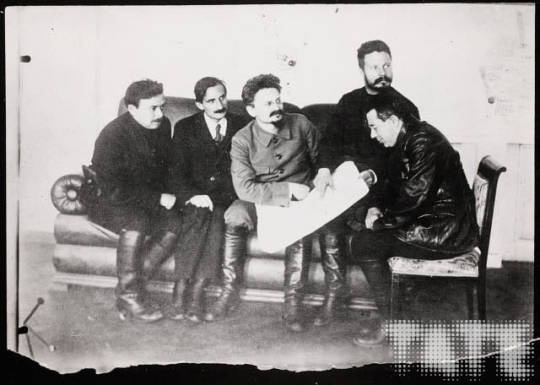
Trotsky in conversation with Béla Kun, Alfred Rosmer, Mikhail V. Frunze and Sergey Gusev, 1920.
Via Tibor Szamuely
10 notes
·
View notes
Note
Ha a Szikra mozgalom hozza magával a nemzetközi antifa-kapcsolatait, a Párbeszéd pedig becsatornázza az Extinction Rebellion meg a Fridays for Future forrófejű fiataljait, kész is az új tanácsköztársaság erőszakos magja. Szabó Tímea lesz az új Kun Béla!
Persze, csináljanak forradalmat, csak ne járjon túl nagy zajjal, mert akkor valagba rugdosom őket
2 notes
·
View notes
Text
Some interesting facts about Béla Lugosi’s time in Hungary from Gary D. Rhodes and Bill Kaffenberger’s Becoming Dracula Vol 1.
A fire broke out in the town of Sátoraljaújhely in late March of 1908, Lugosi's served as a volunteer rescue worker and was praised by a local newspaper for his actions.
He could sing, and did so for a number of theatrical roles
Described by female admirers in local theatrical journals as "sweet creature!", "beautiful Romeo", "adorable", "sweet featherbrain", and "handsome boy". A particularly enamored woman wrote that he was her favorite "because he is so tall that one can only kiss him by climbing up a chair. Wow, that must be so... well... so tasty."
When a local critic complained that there were no good performances in Szeged theatre, Lugosi said "One must only look at [my] handsome figure and be convinced of the very opposite."
Was credited as Arisztid Olt in Hungarian silent films rather than as the recognizable 'Béla Lugosi', most likely due to the fact that the studio producing the movies had claimed that they had trained their own actors rather than recruiting theatre actors.
Lugosi passed an exam and was admitted into the Budapest Royal Hungarian Academy as a law student in 1914. He ultimately did not attend due to the outbreak of WWI.
He wasn't just a supporter of Béla Kun's Communist government, but was a member of the party and worked within Kun's government as well.
Was the secretary of the Actor's Union and was in charge of finding positions for unemployed actors.
4 notes
·
View notes
Text
Savage Béla Kun to y'all 💅🏻
2 notes
·
View notes
Text
Arnold Hauser Sejarawan Sosial Seni
MIRMAGZ.com - Arnold Hauser merupakan penulis Inggris kelahiran Hongaria yang menulis tentang sejarah seni dan film. Magnum opus Hauser adalah The Social History of Art. Ketika karya tersebut muncul dalam bahasa Inggris pada 1950-an, jauh sebelum munculnya New Left (New Left adalah gerakan politik yang luas terutama pada tahun 1960-an dan 1970-an yang terdiri dari aktivis di dunia Barat yang berkampanye untuk berbagai masalah sosial seperti hak-hak sipil dan politik, feminisme, hak gay, hak aborsi, peran gender dan kebijakan narkoba. reformasi.), hal itu menimbulkan kontroversi besar karena orientasi ideologisnya.

Arnold Hauser dikutip dari Wikipedia
Baru pada tahun 1960-an dan 1970-an pendekatan Marxis diterima sebagai bagian alami atau modis dari penelitian akademis di Eropa Barat. Namun, Marxisme mulai kehilangan daya tariknya di kalangan intelektual sebelum runtuhnya Uni Soviet. Sejarawan seni postmodernis jarang merujuk pada studi fundamental Hauser.
Seni yang asli dan progresif hanya dapat berarti seni yang rumit hari ini. Tidak mungkin semua orang dapat menikmati dan menghargainya dalam ukuran yang sama, tetapi bagian dari massa yang lebih luas di dalamnya dapat ditingkatkan dan diperdalam, Prasyarat dari kelonggaran monopoli budaya di atas segalanya adalah ekonomi dan sosial. Kita tidak bisa berbuat apa-apa selain memperjuangkan penciptaan prasyarat ini.
(dari Social History of Art, vol. 4)
Arnold Hauser lahir di Temesvar (sekarang Timisoara, Rumania), dari sebuah keluarga Yahudi yang berasimilasi. Ia belajar sejarah seni dan sastra di universitas Budapest, Wina, Berlin, dan Paris.
Di Paris gurunya adalah Henri Bergson yang sangat mempengaruhinya. Untuk mendapatkan penghasilan tambahan, dia melaporkan acara seni, sastra, dan budaya untuk Temesvári Hírlap (Temesvár News). Selama beberapa waktu dia menjadi guru di Budapest Gymnasium.
Pada tahun 1916 Hauser menjadi anggota Budapest Sunday Circle, yang dibentuk di sekitar kritikus dan filsuf György Lukács. Kelompok tersebut termasuk Karl Mannheim, seorang sosiolog, penulis Béla Balázs, dan musisi Béla Bartók dan Zoltán Kodály. “Minggu sore dan malam hari ini,” Hauser kemudian mengenang, “tetap menjadi pengalaman terbesar dalam hidup saya, karena orang-orang luar biasa yang berkumpul di sana.” (‘Arnold Hauser and the Retreat from Marxism’ oleh Lee Congdon, dalam Essays on Wittgenstein and Austrian Philosophy: In Honor of J.C. Nyiri, diedit oleh Tamás Demeter, 2004, hlm. 42)
Selama kediktatoran Komunis Bela Kun yang berumur pendek pada tahun 1919, Hauser bertanggung jawab atas reformasi pendidikan seni. Seperti Mannheim, dia tidak bergabung dengan gerakan komunis. “Mereka,” tulis simpatisan komunis Balázs dalam buku hariannya, “menjadi yatim piatu dan tidak memiliki akar di luar hari Minggu, dan mereka tidak dapat menemukan ceruk spiritual atau profesional yang sesuai di mana pun … Mereka merasa bahwa mereka telah ketinggalan kereta di stasiun jalur provinsi. ” (Georg Lukács and His Generation, 1900-1918 oleh Mary Gluck, 1985, hal.212)
Setelah penggulingan Kun, Hauser menghabiskan dua tahun bersama istrinya di Italia untuk melakukan penelitian tentang sejarah seni klasik dan Italia dan mendapatkan gelar Ph.D. di Budapest. Disertasinya membahas masalah sistematisasi estetika.
Pada 1921 ia pindah ke Berlin, di mana ia belajar ekonomi dan sosiologi. Saat itu ia telah mengembangkan pandangannya bahwa masalah seni dan sastra pada dasarnya adalah masalah sosiologis. Tiga tahun kemudian, ketika istrinya menyatakan bahwa dia ingin tinggal lebih dekat ke Hongaria, pasangan itu menetap di Wina, di mana Hauser mendukung dirinya sebagai penulis lepas dan sebagai agen publisitas sebuah perusahaan film.
Di sela-sela itu dia mengerjakan sebuah buku yang belum selesai, berjudul Dramaturgie und Soziologie des Films. Kemudian dia berkata, bahwa “Bagi saya ini adalah periode pengumpulan data dan pengalaman yang saya gunakan kemudian dalam perjalanan saya menulis karya saya tentang sosiologi seni.”
Melarikan diri dari Nazi setelah Anschluss di Austria, Hauser beremigrasi dengan istrinya ke Inggris Raya; dia meninggal karena pengaruh tak lama setelah kedatangan mereka. Sendirian dan tanpa penghasilan tetap, Hauser pertama kali dibantu oleh teman lamanya Mannheim, yang mengedit seri buku untuk Routledge dan Kegan Paul. Ketika rencana untuk pekerjaan mereka tentang sosiologi seni ditinggalkan, dia kemudian mulai meneliti Sejarah Sosial Seni. Butuh sepuluh tahun untuk menyelesaikan survei Marxis.
Karya besarnya lebih dari seribu halaman dan panjang 500.000 kata keluar ketika ia berusia 59 tahun. Masih mengikuti apa yang terjadi di dunia film, Hauser juga menulis sejumlah esai tentang film untuk Life and Letters Today dan Sight and Sound . Hauser diberikan kewarganegaraan Inggris pada tahun 1948.
Dikutip dari: http://authorscalendar.info/hauser.htm
Read the full article
0 notes
Text
服務器討厭來自另一方的熱情好客的 5 件事
例子包括蜱傳腦炎疫苗,必須每隔幾年重複一次才能產生持久保護,或者流感,由於病毒的變異性,每年都需要一種新疫苗才能受到保護。 結果表明,疫苗對較新的冠狀病毒���種也有效,特別是如果過去開發的提醒免疫力的疫苗也得到加強。 此外,mRNA 疫苗的 omicron 變體的加強疫苗接種已經完成。 隨著時間的推移,如果您在此後的一段時間內沒有遇到病原體,您的身體就會忘記疫苗接種所教的內容。 外燴 通過疫苗接種獲得的免疫力可能會隨著時間的推移而減弱或完全消失。 在這種情況下,另一劑疫苗會提醒我們的身體,當它看到病原體時必須做什麼。
流量收斂為零,Árkád 幾乎沒有人,尤其是與有優惠券日的事實相比,當流量通常是其十倍時。 目前,他們正在監視事件,尚未決定會發生什麼,但計劃應該推遲。 Tibor Rebák 表示,作為分銷商,他們除了餐飲之外還有其他收入來源,但預計訂單也會減少。 布達佩斯的 Helia 酒店在 11 月 15 日至 12 月 15 日期間為客人提供經典的斯堪的納維亞美食。 我不後悔創新,我不後悔錢,我寧願後悔花在不必要的談話上的時間 - Attila Hegyi 在接受 Üzletem 採訪時說。 我不後悔花錢來增加我的知識,也不後悔花錢購買美味的食物和飲料,Attila Fiáth 對 Üzletem 說。
在匈牙利貿易分公司,他們受到了友好的歡迎和 他們饒有興趣地問起我在廣州的經歷。 蓋章信件,說明在國外服務一年半後,一切都是免稅的
也就是說,如果今天有兩個感染者,那麼明天就會有四個, 到下週一,將有 14 例新感染病例。
具體時間取決於疫苗接種的類型。 然而,在我們跑到藥店之前,值得知道的是,目前沒有證據表明阿司匹林可以幫助預防這些病例。 儘管如此,母乳喂養的好處如此之多,以至於如果母親病得不是太重而不能這樣做,大多數專家都認為母乳喂養的積極作用足夠大,值得冒這個險。 如果這不能說服您,或者如果您認為您的病例中血栓形成的風險高於平均水平,您可以選擇基於 mRNA 或滅活病毒的疫苗。 屏東 外燴 患者可以接受血小板輸注以補充因疾病而丟失的血小板,以及非肝素抗血栓治療以防止血栓形成。
每一刻鐘輪班,每個人都在餐車上取餐 中午和晚上的部分米飯。 每個艙室都有熱水瓶, 列車乘務員確保定期更換空熱水瓶。 奇奇口渴時為自己泡茶。 在火車上吃飯的成本比在城市食堂低 乘客需要照顧,餐車不宜高
存在於歐洲某處,具有三個匈牙利語名稱。 提到了偉大的足球明星“Puszkasz”,而 Károlyi 也為人所知 關於 Mihály 和 Béla Kun,他們在黨的研討會上認識了他們的名字,
在疫苗的開發過程中,製造商要克服一系列這樣的障礙,這會使疫苗的開發時間延長數月甚至數年。 縮短工藝時間不會影響疫苗的質量。 疫苗接種必須滿足與以前相同的嚴格條件。 第五,疫苗背後的技術近年來發展迅速。
根據他們的經驗,維生素 D 治療幾乎總能阻止患者被送入重症監護病房。 微波爐內部的輻射是不均勻的。 只有當你放入的所有東西都被加熱到足夠高的溫度時,你才能確定病毒已經被殺死。 乾旱通常意味著更糟糕的病毒環境,所以如果你把麵包放在烤箱裡是因為你擔心它可能在商店裡被夾住,烤麵包非常適合去除病毒。 可能讀到這種病毒對熱不是很敏感,只有接近源頭的溫度才足以摧毀它,但這並不完全正確。 本文的基礎是一項在實驗室條件下測試病毒熱滅活的研究。 結果是較低的溫度(56°C 30 分鐘和 60°C 60 分鐘)並沒有殺死 100 percent 的病毒,但確實殺死了 ninety nine.999%。

準確的計數和測量很重要,因為存在短缺或過剩 在短缺的情況下,業主有權要求員工支付所發生的費用 短缺,因為如果企業可以將其出售給所有者 Várnai 還談到了這樣一個事實,即雇主意識到,稍微誇張地說,沒有勞動監察,“所以雇主為所欲為,因為他知道沒有人會檢查他是否合法僱用工人”。
0 notes
Text
Ranglista 2022.
Pontszámok - a dokumentált versenyeredmények alapján
Utolsó verseny 2022.06.12.
Férfi ranglista

1. Berecz Árpád – 21x egyéni és 21x páros szegedi bajnok, 1x országos egyéni bajnok, 2x országos páros bajnok, 2x nemzetközi egyéni bajnok, 3x nemzetközi páros bajnok 252 pont
2. Bronner Dezső – 1x szenior egyéni 17x páros szegedi bajnok, 1x országos páros bajnok, 1x nemzetközi szenior bajnok 126 pont
3. Dr. Harsányi Géza – 22x szegedi bajnok egyéni és páros 101 pont
4. Császár József Endre – 3x ifjúsági, 1x férfi egyéni és 3x páros szegedi bajnok 87 pont
5. Korom Árpád – 3x páros szegedi bajnok, 1x országos szenior bajnok 53 pont
6. Dr. Matusovits László – 1x szenior egyéni és 6x páros szegedi bajnok 49 pont
7. Németh István – 1x egyéni és 3x páros szegedi bajnok 34 pont
8. Molnár István – 1 x szenior egyéni és 2x páros szegedi bajnok 32 pont
9. Berecz Ádám – 2x ifjúsági egyéni és 1x páros szegedi bajnok, 1x páros nemzetközi bajnok 29 pont
10. Márkus János – 1x egyéni és 2x páros szegedi bajnok 28 pont
11. Zsivicz József – 1x szenior nemzetközi bajnok 27 pont
12. Varga Ádám – 1x ifjúsági egyéni szegedi bajnok 26 pont
13. Apjok Ferenc – 3x vegyes páros szegedi bajnok 22 pont
14. Ifj. Berecz Árpád – 1x ifjúsági egyéni és 1x páros szegedi bajnok 20 pont
15. Szarka Lajos - 2x egyéni és 2x páros szegedi bajnok 18 pont
16. Dr. Hertelendi Péter
Ifj. Thékes István Phd. – 1x ITGO páros bajnok Velence
Tiszai Zoltán – 1x páros szegedi bajnok 17 pont
17. Dr. Thékes István – 1x ITGO páros bajnok Velence 16 pont
18. Papp József – 1x páros szegedi bajnok 15 pont
19. Jókai Zoltán Phd. – 1x egyéni budapesti világbajnok és 1x páros világbajnok (nem hivatalos) 13 pont
20. Gyémánt Károly – 3x ifjúsági páros bajnok 12 pont
21. Tóth József – 1x ifjúsági és 1x páros felnőtt szegedi bajnok
Schmödl József – 2x felnőtt páros szegedi bajnok
Földesi László – 1x páros budapesti világbajnok (nem hivatalos)
Kelemen Zoltán – 2x páros szegedi bajnok 11 pont
22. Kovács Csaba – 1x páros szegedi bajnok
Bakó András 10 pont
23. Dr. Börcsök Vince
Csorba Attila – 1x ITGO egyéni világbajnok Velence
Pápai Miklós – 1x egyéni és 1x páros szegedi bajnok 9 pont
24. Edo Camdzija (Szerbia) – 1x páros bajnok 8 pont
25. Fülöp Tamás (Gyöngyös)
Zsivicz Máté – 1x gyermek szegedi bajnok 7 pont
26. Dr. Benedek György -1x ifjúsági és 1x felnőtt páros szegedi bajnok
Faragó László
Kiss Lajos
Kanczler László (Ajka)
Id. Dr. Szabó László 6 pont
27. Hora Gábor – 1x ifjúsági egyéni szegedi bajnok
Galgóczi Tibor
Papp Gábor
Smohai Balázs
Urbán Tamás – 1x ifjúsági egyéni szegedi bajnok 5 pont
28. Ifj. Bronner Dezső
Bánfi Attila
Bába Gábor – 1x ifjúsági egyéni szegedi bajnok
Hollender Dávid - 1x nemzetközi ifjúsági egyéni bajnok (Németország)
Keresztes Tibor
Ifj. Pazonyi György (Nyíregyháza) – 1x országos ifjúsági bajnok
Rácz Imre
Schilsong Máté
Velkey András (Cegléd) 4 pont
29. Kun Kristóf 3,5 pont
30. Bakó Péter
Berecz István
Csanyevácz
Domenico Cocimano (Olaszország)
Dervarics Gergely (Svájc)
Dobó József
Hovanyecz Tamás
Luca Eid (Olaszország)
Kass Ferenc – 1x gyermek egyéni szegedi bajnok
Lajkó Ferenc
Magda Péter – 1x páros szegedi bajnok
Németh Balázs
Maurice Rihm (Németország)
Sárszegi György – 1x páros szegedi bajnok
Szentesi Szabolcs
Szőcs Mihály
Vincze István
Zahorán Dániel 3 pont
31. Csapó József
Péter Martin – 1x ifjúsági páros szegedi bajnok 2,5 pont
32. Ágoston Zsolt
Balogh Martin – 1x ifjúsági páros szegedi bajnok
Berecz István
Bullás Imre
Csatos Sándor
Guilio Frizzi (Olaszország)
Hollender Dávid (Németország)
Jarolics Bendegúz (Budapest)
Jarolics Béla (Budapest)
Juhász Imre (Gyöngyös)
Id. Kecskés Tamás
Korom István
Kovács Ákos
Molnár Attila
Nagy
Nagy János
Papp Jenő
Pördi Péter
Schilsong János
Süle Mihály
Sümegi Soma
Schmödl II.
Dr. Szendrényi
Ungi Zoltán
Varga Béla II.
Veres
Dr. Veszprémi László 2 pont
33. Zawiása Bernát 1,5 pont
34. Bánsági
Bodó Zoltán
Burkus
Cserne
Csetneky
Dervarics Máté
Dorka Péter Botond
Göblyös Dávid
Gyüdi András
Honthegyi
Krisztin
Stika Péter
Id.Pazonyi György (Nyíregyháza)
Dr. Thékes László
Ifj. Thékes László
Túri-Nagy Róbert
Varga Viktor 1 pont
35. Szabó Tamás
Tölgyesi Ferenc
Varga Fortunátó 0,5 pont
Női ranglista
1. Joó Gyöngyi – 11x egyéni és 16x páros szegedi bajnok, 3x nemzetközi egyéni, 6x nemzetközi páros bajnok, 2x országos páros bajnok, 247 pont
2. Börcsök Abigél – 8x egyéni és 14x páros szegedi bajnok, 3x nemzetközi egyéni bajnok, 6x nemzetközi páros bajnok, 1x országos egyéni és 2x országos páros bajnok 194 pont
3. Császár Hédi Gyöngyi – 1x egyéni és 6x páros szegedi bajnok 57 pont
4. Berecz Andrea – 5x páros szegedi bajnok 43 pont
5. Császárné Dancsó Etelka – 3x páros szegedi bajnok 24 pont
6. Nagy Ágnes Virág – 1x nemzetközi páros bajnok, 2x szegedi páros bajnok
Zsivicz Dorina – 1x nemzetközi ifjúsági egyéni bajnok 20 pont
8. Molnár Gyöngyi – 1x egyéni szegedi bajnok 16 pont
9. Rúzsa Tímea 15 pont
10. Márkus Aranka
Németh Ágnes – 2x junior egyéni és 2x páros szegedi bajnok 14 pont
11. Márkus Jánosné 13 pont
12. Doktor Mária 12 pont
13. Berecz-Varga Zsuzsanna
Hocza Ágnes 11 pont
14. Kiss Sára 10 pont
15. Hollender Emma – 1x nemzetközi egyéni ifjúsági bajnok (Németország)
Dr. Tokodi Margaréta – 1x páros szegedi bajnok 8 pont
16. Apjok Katalin – 1x páros szegedi bajnok 7 pont
17. Keresztúry Adrienn – 1x egyéni szegedi bajnok 6 pont
18. Bánkuti Klára – 1x páros szegedi bajnok
Bátor Csenge – 1x nemzetközi páros bajnok
Fülöpné Dóra Mariann (Gyöngyös)
Garamvölgyi Judit
Lipták Anna
Szilágyi Nóra
Simoncsics Ildikó
Zeller Abigél 5
19. Duba Diána
Major Éva 4 pont
20. Arkauer Tiborné – 1x páros szegedi bajnok
Bozsár Liza
Dervarics Lilla (Svájc)
Németh Hanna Júlia
Rocskár Ildikó – 1x serdülő egyéni szegedi bajnok
Schmödl Emmi – 1x páros szegedi bajnok
Szászi Veronika – 1x ifjúsági egyéni szegedi bajnok 3 pont
21. Antalffy Ágnes
Csóti Ildikó
Dervarics Bernadett
Erdődi Anna
Fiedler Judit
Győri Emilné
Hajdú Csilla
Hovanyecz Piroska
Ihász Ildikó
Kocsis Enikő
Kókai Dalma
Németh Anikó
Simicz Ilona
Sóti Boglárka
Tóth Éva
Vadkerti Gréta
Varga Réka
Vas Andorné
Várhelyi Ágnes 2 pont
22. Ciocanel Diána (Olaszország)
Cságoly Éva
Kertész Dóra
Király Veronika
Magosi Anna
Németh Anikó
Pazonyi Judit (Nyíregyháza)
Pazonyi Réka (Nyíregyháza)
Schilsong Enikő 1 pont

0 notes
Photo
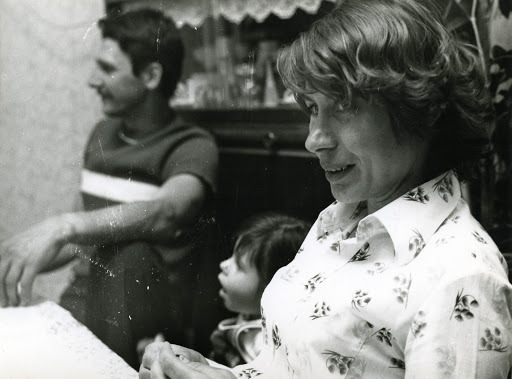
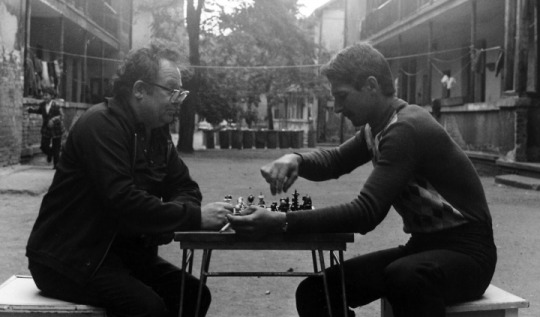

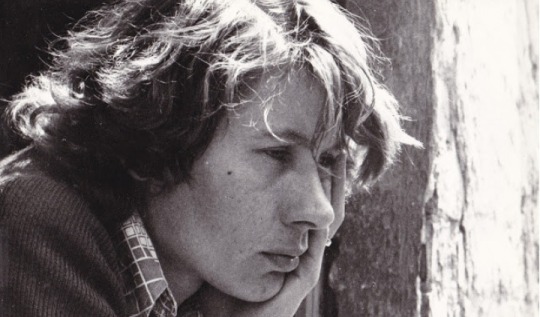
Családi tűzfészek (rendezte: Tarr Béla)
31 notes
·
View notes
